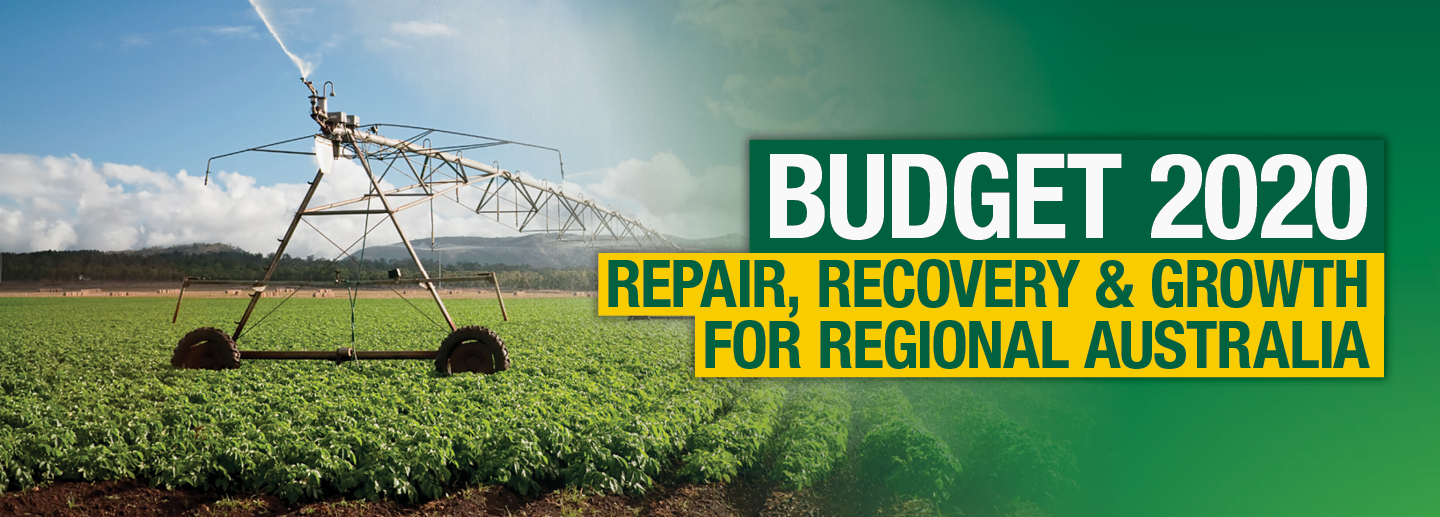Regional Australia gets a big boost from the Budget, and that has been the Nationals’ priority.
Infrastructure
Tonight, we’ve announced $10 billion in additional infrastructure commitments, bringing our infrastructure pipeline to $110 billion.
Our significant investment will support Australia’s recovery, with projects currently under construction expected to support over 100,000 direct and indirect jobs over the life of the projects, at a time we need it most.
This includes:
- $2 billion over 18 months for a new Road Safety Program, which will deliver upgrades such as wire rope safety barriers, shoulder sealing and rumble strips
- An additional $1 billion for local governments for the Local Roads and Community Infrastructure Program (LRCI)
Funding is being delivered to critical transport infrastructure projects in every state and territory, including:
- an additional $490.6 million for the Coffs Harbour Bypass in New South Wales;
- $528 million for upgrades to the Shepparton and Warrnambool rail lines in Victoria;
- $750 million for Stage 1 of the Coomera Connector in Queensland;
- an additional $80.0 million for the Wheatbelt Secondary Freight Network in Western Australia;
- $136 million to progress the Main South Road Duplication in South Australia;
- $65 million for the Tasman Bridge Upgrade in Tasmania;
- $46.6 million for National Network Highway Upgrades in the Northern Territory; and
- $87.5 million for the Molonglo River Bridge in the Australian Capital Territory.
Together, the LRCI and Road Safety Program will support more than 10,000 jobs across the nation.
Water infrastructure
At last year’s election, we made it clear that water infrastructure was a priority for The Nationals and for regional Australia. We established the National Water Grid Authority and tonight we’ve put up an additional $2 billion in funding for projects through the National Water Infrastructure Development Fund.
This more than doubles the fund to a total of $3.5 billion, which will become a 10 year rolling program of priority water infrastructure investments.
We’ve heard loud and clear from our membership that for regional Australia to thrive, you need to add water. That’s what we’re doing and progress is already underway on Dungowan and Wyangala Dams.
Regional development, health and communications
Regional Australia is also set to benefit from $200 million in grants for Round Five of the successful Building Better Regions Fund, $100 million of which will be dedicated to tourism-related infrastructure.
In addition, $100 million will be invested to establish the new Regional Recovery Partnerships, and $22.7 million for Round Six of the Stronger Communities Programme, which provides grants of between $2,500 and $20,000 across the country to community organisations and local governments for small capital projects that deliver social benefits for local communities.
Minister for Regional Health and Regional Communications Mark Coulton has also secured $22.1 million for the Australian 5G Innovation Initiative, which will test 5G in key sectors including agriculture, manufacturing, mining and logistics. $30.3 million has been provided for the Regional Connectivity Program to support telecommunications projects developed by local communities.
There is also $50.3 million to expand the rural training pipeline through the RHMT program and $125 million for Rural and Regional Clinical Trials.
Agriculture
Deputy Leader David Littleproud and our team are positioning agriculture as a key driver of Australia’s economic and regional recovery. Our plan supports farmers and industry to help Australian agriculture reach $100 billion by 2030.
A signature $328.4 million investment will deliver a one-touch export portal, replacing a cumbersome system that still forces farmers to use carbon paper before they can send their produce overseas. This cutting edge technology will further support farmers who have been hit by drought, bushfires and COVID-19.
A further $317.1 million will continue to support flying Australian produce overseas by extending the International Freight Assistance Mechanism until the middle of next year. This initiative will continue to keep Australian farmers in business by ensuring they can get their high-quality produce into key export markets and that they stay connected with their overseas customers.
This system will support our National Agricultural Innovation Agenda. This Agenda includes a $1.3 million to create Agricultural Innovation Australia Ltd, which will drive a cross-industry approach on research and development; develop a Digital Foundations for Agriculture Strategy to drive long-term collaboration; and $86 million for eight new adoption and innovation hubs under the Future Drought Fund. These measures provide practical research outcomes for farmers, and help them innovate, take up new technologies and build their resilience.
The Nationals are incentivising Australians to join the agricultural workforce and address labour shortages in regional areas. Our plan will pay young Australians up to $6,000 for costs like accommodation and transport, with $17.4 million in funding. They will also get early access to Youth Allowance or ABSTUDY at a cost of $16.3 million.
We will provide $2.7 million to alleviate cash flow pressures for agricultural field days that cancelled their events in 2020 due to COVID-19. This is in addition to $36.3 million to support agricultural shows, which provide significant social and economic value every year to regional communities across Australia.
The Government is preparing Australia for future natural disasters while supporting regional areas that have already been affected by fires, flood and cyclones. We are investing in mitigation, response and recovery. This includes an extra $26 million to boost aerial firefighting through the National Aerial Firefighting Centre, giving public safety agencies access to reliable and secure communications through an $8 million proof of concept trial for the Public Safety Mobile Broadband.
While bushfire recovery from the 2019-20 continues through the $2 billion National Bushfire Recovery Agency, we have not forgotten those still dealing with the aftermath of the 2019 North Queensland Floods. The Government will provide $60 million to roll out the North Queensland Flood and National Drought Agency’s Flood strategy, which will make communities more resilient in the longer term.
Northern Australia and Resources
In resources, we are committing a further $125 million to our Exploring for the Future program over the next four years to help attract local and international investment in mining, additionally we are investing $28.3 million to drive five Strategic Basin Plans to accelerate the development of our vast gas and mineral resources.
Our reforms to the Northern Australia Infrastructure Facility (NAIF) will ensure the $5 billion facility will have more flexibility to bankroll investment in a wider range of projects across Northern Australia.
Our new Murray–Darling Communities Investment Package, coming in at more than $230 million will put communities at the centre of the Murray–Darling Basin Plan with a focus on jobs and economic activity in regional areas.
Decentralisation
The Nationals are revitalising our commitment to decentralisation in the 2020/21 Budget. These changes are the first step on a journey to refresh the decentralisation agenda to ensure it remains a crucial element of the Government’s broader commitment to creating jobs and supporting the economic prosperity of our regions.
We’re broadening our approach to decentralisation so that it incorporates the private sector, and capitalises on trends that have emerged during the COVID-19 pandemic – with more businesses and people considering a tree-change than ever before.
As a first step, we’re investing $41 million in a decentralisation research and development policy package that will drive closer research collaboration between businesses and research organisations in priority regional industries. The package includes two programs:
- COVID-19 has highlighted the need for businesses to secure supply chains in Australia. The $35 million Securing Raw Materials Program will support businesses that relocate to regional Australia with investments in research and development into securing raw material inputs.
- The $6 million Regional Cooperative Research Centre Project (RCRC-P) Program will fund short-term research projects led by industry that will deliver commercial outcomes and create jobs for important regional industries.
We’re making it easier for Government agencies to relocate their operations to regional Australia by removing the handbrake on them doing so.
Government agencies wishing to decentralise will no longer have to fund the move to the regions through internal budget savings, making it easier for departments to take the decision to relocate to the bush.
We’ve also changed the location criteria for the decentralisation of Government agencies to ensure it is only regional communities that benefit from the move. The criteria previously only required the relocation to be outside of Canberra, inner-city Melbourne and inner-city Sydney, whereas they will now be required to relocate their operations outside of six of Australia’s capital cities (Adelaide, Brisbane, Canberra, Melbourne, Perth, Sydney).
Veteran Affairs and Defence Personnel
Minister for Veteran Affairs and Defence Personnel Darren Chester has ensured support for the defence community by securing $101.7 million to further bolster mental health support, including increasing fees paid to mental health, social work and community nursing providers, and expanding Open Arms – Veterans & Families Counselling, especially in regional and remote areas.
While also providing $23.7 million for increased transition and employment support, including the establishment of a Joint Transition Authority (JTA) to ensure all transition services and supports are working together, and greater civilian employment opportunities for veterans and support for those starting their own business.
The Government has also committed $25.9 million to deliver additional assistance for Totally and Permanently Incapacitated (TPI) veterans, including increased support for those that live in rented accommodation.
11,000 Australian companies directly benefit from the Defence investments, and when further downstream suppliers are included the benefits flow to approximately 70,000 workers. To boost this, the Government will provide Defence with $42.7 billion in 2020-21 and $190.2 billion over the Forward Estimates.
This includes $24.3 billion of active infrastructure projects spread throughout Australia’s states and territories, including our regions, which since the implementation of the Local Industry Capability Plans has seen 73 per cent of infrastructure work awarded to local companies and businesses.
Australia currently has around 2,300 Defence personnel deployed around the world, including on operations across the Indo-Pacific and the Middle East region, the Government is supplying $728 million to continue funding to major operations.

